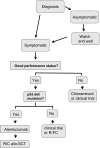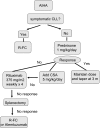How I treat CLL up front
- PMID: 19850738
- PMCID: PMC2941409
- DOI: 10.1182/blood-2009-08-207126
How I treat CLL up front
Abstract
Although chronic lymphocytic leukemia (CLL) remains incurable, over the past decade there have been major advances in understanding the pathophysiology of CLL and in the treatment of this disease. This has led to greatly increased response rates and durations of response but not yet improved survival. Advances in the use of prognostic factors that identify patients at high risk for progression have led us to the question whether there is still a role for a "watch and wait" approach in asymptomatic high-risk patients or whether they should be treated earlier in their disease course. Questions remain, including, what is the optimal first-line treatment and its timing and is there any role of maintenance therapy or stem cell transplantation in this disease? CLL is a disease of the elderly and not all patients are eligible for aggressive up-front chemoimmunotherapy regimens, so what is the optimal treatment approach for more frail elderly patients? It is highly likely that our treatment approaches will continue to evolve as the results of ongoing clinical trials are released and that further improvements in the outcome of this disease will result from identification of therapies that target the underlying pathophysiology of CLL.
Figures
References
-
- National Cancer Institute. SEER Stat Fact Sheets: Chronic Lymphocytic Leukemia. [Accessed November 11, 2009]. http://seer.cancer.gov/statfacts/html/clyl.html.
-
- Yuille MR, Matutes E, Marossy A, Hilditch B, Catovsky D, Houlston RS. Familial chronic lymphocytic leukaemia: a survey and review of published studies. Br J Haematol. 2000;109(4):794–799. - PubMed
-
- Ishibe N, Sgambati MT, Fontaine L, et al. Clinical characteristics of familial B-CLL in the National Cancer Institute Familial Registry. Leuk Lymphoma. 2001;42(1-2):99–108. - PubMed
-
- Hallek M, Cheson BD, Catovsky D, et al. Guidelines for the diagnosis and treatment of chronic lymphocytic leukemia: a report from the International Workshop on Chronic Lymphocytic Leukemia updating the National Cancer Institute-Working Group 1996 guidelines. Blood. 2008;111(12):5446–5456. - PMC - PubMed
Publication types
MeSH terms
Grants and funding
LinkOut - more resources
Full Text Sources
Other Literature Sources
Medical
Miscellaneous



